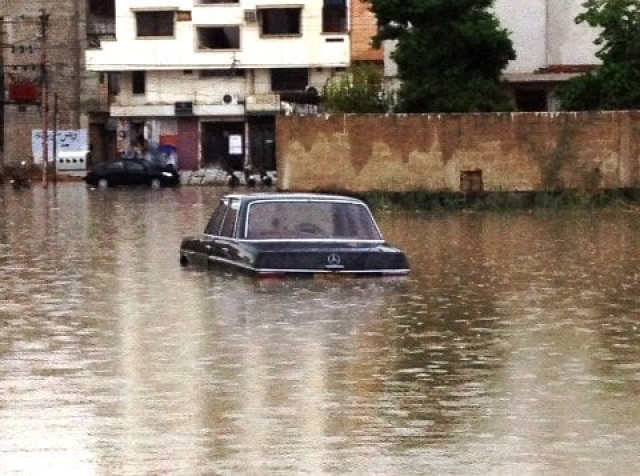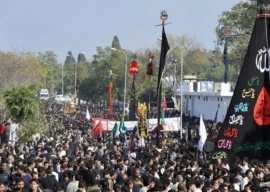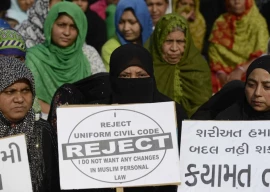
With the fear of monsoon-related floods looming large across the country, rain drains in Karachi, Lahore and Peshawar require cleaning. Most major stormwater drains are either obstructed or in some cases -- encroached, which results in choking the drainage system responsible for keeping rainwater off the roads.
For Karachi, the choked drainage system remains the city’s Achilles’ heel, putting the city at risk of urban flooding during every monsoon. Last month, just before the arrival of monsoon, the city administration in Karachi sprang into action to clear the blocked drains.
Flooding, power cuts pile on misery for Karachi after rain spell
According to documents gathered by the Express Tribune, all of Karachi’s more than 550 rain drains were either clogged or encroached upon and need to be cleared ahead of the rainy season.
The cleaning operation continued even as the city received its first monsoon rain last month. With roughly 113mm of rain during July and more expected around Eidul Azha, the city may still witness inundated streets.
Experts believe the accumulation of solid waste chokes the city’s natural waterways and the lack of regular cleaning results in blockages that cause the rainwater to spill over, creating problems for the citizens. Besides, the construction of markets and other establishments over drains, solid waste dumped into the drainage system is a serious obstacle in the passage of rainwater.
For Karachi, the first downpour of the season was a reality check for the city’s administration. Even while 38 major storm drains were cleaned by the Karachi Municipal Corporation and Sindh Government, the administration of six districts municipal corporations was unable to complete the cleaning of clogged drains.
Despite spending whooping Rs 1.2billion on cleaning Karachi’s clogged rain drains; the city administration failed to prevent the accumulation of garbage in storm drains. Residents of Karachi’s slums continue to dump garbage in storm drains, which has resulted in permanently or partially choking some rain drains.
Extreme monsoon to cause flooding, landslides, Senate body told
“The Sindh government does not provide adequate funds to the District Municipal Corporations,” officials at a DMC said, speaking on condition of anonymity.
Officials said Karachi’s storm drains are vulnerable to the ever-present threat of encroachments. Despite orders from the Supreme Court of Pakistan, 95 percent of encroachments including private and government buildings are still present due to which the drains cannot be completely cleaned.
Lahore
As heavy monsoon rainfall lashed Lahore, its streets, too, were inundated. Out to inspect the rain-related damage, Punjab Chief Minister Usman Buzdar had to rescue stranded women and children.
According to a source at Water and Sanitation Agency (WASA), a total of 260 out of 350 small and big drains in Lahore have been occupied, paralysing the city’s drainage system.
Several deaths were reported in different rain-related incidents across the province. The rain caused heavy flooding on the roads and suburban areas of Punjab’s capital city.
Elsewhere, more than 20 districts in Punjab, including Jhelum, Sargodha, Khushab, Jhang, Muzaffargarh and DG Khan are susceptible to flooding due to monsoon rains that are now sweeping across the province.
“All departments have been preparing for the onset of monsoon season in the province,” claimed PDMA Punjab Director Tariq Masood Farooqa.
“Both Water and Sanitation Agency (WASA) and Water and Power Development Authority (WAPDA) have been clearing clogged sewerage lines, rain drains and nullahs across the province,” he added.
With rains wreaking havoc across the country, the disaster monitoring body in Punjab has increased its coordination efforts in both rural and urban areas of the province.
“There is an emergency at the PDMA office in Lahore. Staff is constantly monitoring the flood situation, rain and its damages across the province,” an official said.
Peshawar
During the rainy season, Khyber-Pakhtunkhwa’s (K-P) capital bears some semblance to Lahore and Karachi. The entry and exit points of the provincial capital are routinely flooded due to rains, paralyzing life in the city.
On its entry from Kohat Road, overflowing drains in Bhana Marhi greet people traveling into the city. Rainwater also flows into the Qissa Khwani area.
During heavy rains, small pushcarts are used to transport people between the two ends of Jahangirpura. The overflowing drain in Kohati, Shahi Khatta which carries the major load of the drain, garbage and other waste is known to leave piles of plastic bags over the sidewalls.
The situation, however, has slightly improved, after the drains were repaired. While there has been an improvement in the drainage system, heavy rainfall still causes problems for the general public, specifically on Grand Trunk Road, University Road, and Charsadda Road.


















COMMENTS
Comments are moderated and generally will be posted if they are on-topic and not abusive.
For more information, please see our Comments FAQ